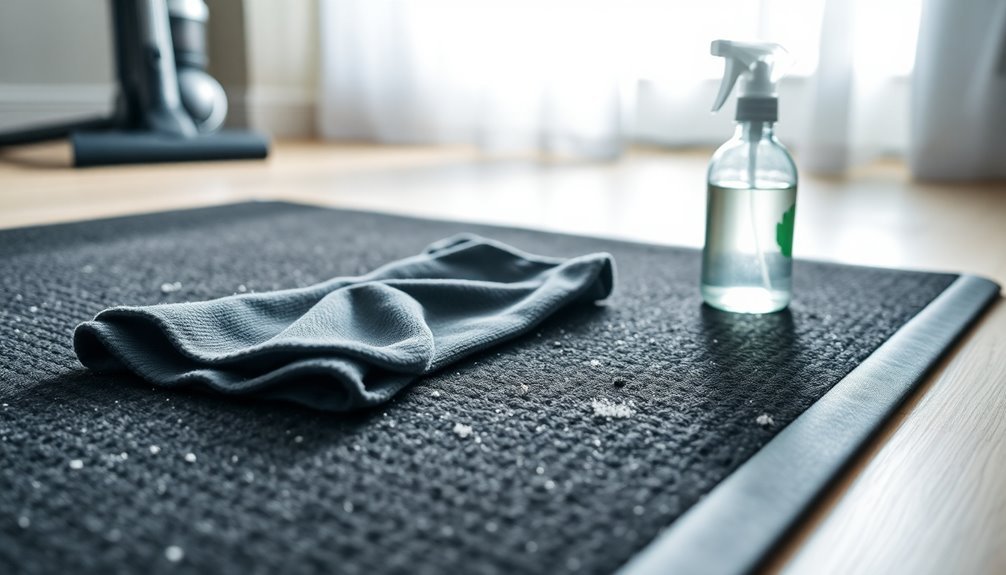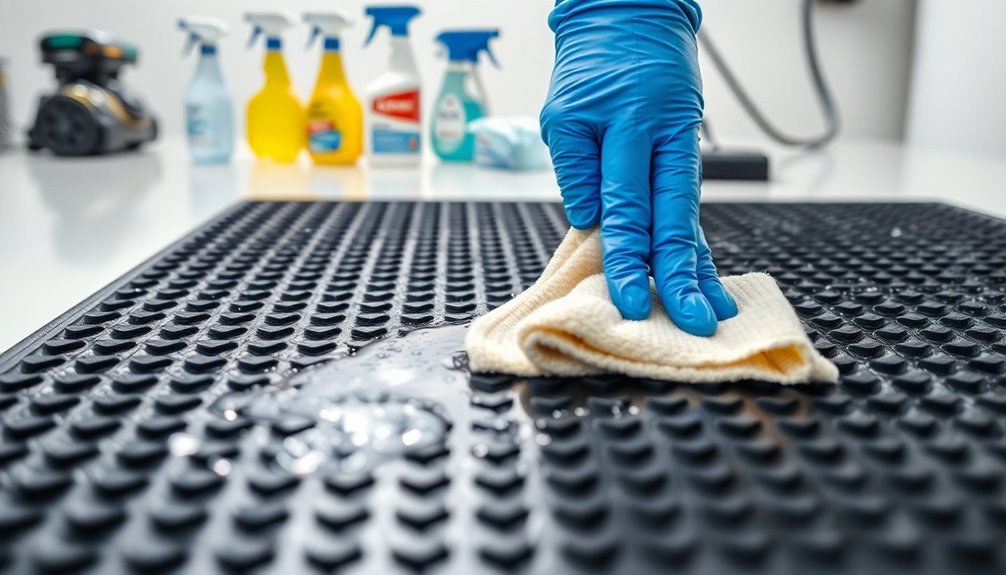Keep your conductive floor mats performing at their peak with these three essential cleaning tips. First, remove loose debris daily using an ESD-safe brush or soft cloth instead of standard brooms that can damage the mat's conductive properties. Second, use only manufacturer-approved, pH-neutral cleaners like Staticide Mat Cleaner or ProtectOHM ESD, avoiding household cleaners with alkali or ammonia. Third, implement a consistent cleaning schedule based on traffic – daily for high-use areas and weekly for low-traffic spots. Understanding proper maintenance techniques can maximize your mat's effectiveness and extend its service life.
Daily Dry Cleaning Methods

Four essential steps make up the daily dry cleaning routine for conductive floor mats.
First, you'll need to prepare the surface by removing all loose debris using a soft cloth or ESD-safe brush. Don't use standard brooms, as they can damage the mat's conductive properties. If static is a concern, you'll want to incorporate static-reducing equipment during this phase. Following proper cleaning ensures that the embedded conductive material continues to collect and dissipate static effectively.
For the actual cleaning process, you'll need to implement dry maintenance techniques to minimize liquid exposure. Regular maintenance through proper cleaning protocols helps protect sensitive electronic components. You can use a rotary buffing machine equipped with appropriate pads, running at 1200-1500 rpm for ideal results.
When needed, apply spray buff solutions containing pH-neutral detergents, but never use products with alcohol or ammonia.
You'll need to establish a cleaning schedule based on mat usage. High-traffic mats require daily attention, while less frequently used mats can be cleaned weekly.
Always coordinate cleaning times to minimize workplace disruptions and use appropriate safety signage.
Safe Deep Cleaning Process
Don't forget to inspect the mat after cleaning and test its anti-static properties to guarantee it's functioning correctly.
You should document your cleaning process and maintain a regular cleaning schedule based on your facility's usage patterns and environmental conditions.
Wait five full days before performing any wet cleaning on newly installed conductive floor mats to ensure proper adhesive bonding.
Using manufacturer-approved ion-free cleaning agents is crucial for preserving the mat's protective qualities and performance.
Protecting Mat Surface Integrity

Proper surface integrity directly impacts the effectiveness of your conductive floor mat's anti-static properties. To maintain peak performance, you'll need to use specific cleaning methods and products designed for ESD materials.
Always opt for pH-neutral detergents and avoid standard floor waxes or finishes that can compromise your mat's anti-static functionality. You should use approved products like Staticide Mat Cleaner, Detergent 8, or ProtectOHM ESD, which are specifically formulated for ESD surfaces. Regular maintenance with these cleaners will help minimize residue build-up over time.
Don't use household multipurpose cleaners or solutions containing alkali or ammonia, as they'll damage the mat's protective properties.
Implement both dry and wet cleaning techniques in your maintenance routine. Start with dry cleaning using an ESD-safe brush to remove loose debris, then follow with wet cleaning using appropriate solutions and soft cloths.
Remember to test your mat's ESD properties after each cleaning session to verify it's functioning correctly.
Keep your cleaning schedule consistent based on usage frequency, and train your staff in proper cleaning protocols.
When using wet cleaning methods, avoid excessive moisture and guarantee thorough drying to maintain the mat's conductive properties.
Frequently Asked Questions
How Often Should Conductive Floor Mats Be Tested for Electrical Resistance?
You should test high-traffic mats every 6-12 months, moderate-use mats every 12-24 months, and low-traffic mats every 24-36 months. Don't forget to test after major cleaning or environmental changes.
Can UV Exposure Affect the Conductivity of ESD Floor Mats?
Yes, UV exposure can greatly affect your ESD floor mats' conductivity, especially if they're rubber-based. You'll notice more degradation in rubber mats compared to vinyl ones, which typically remain unaffected by UV radiation.
What Temperature Range Is Safe for Storing Conductive Floor Mats?
You'll want to store your conductive floor mats between 50°F (10°C) and 80°F (27°C). Don't expose them to temperatures below 30°F (-1°C) or above 100°F (38°C) to maintain their effectiveness.
Do Different Footwear Materials Impact the Effectiveness of Conductive Mats?
Yes, your footwear material directly affects conductive mat performance. You'll get the best static discharge with ESD-compliant shoes, while non-conductive materials like regular rubber or leather can reduce the mat's effectiveness.
How Long Do Conductive Floor Mats Typically Last Before Requiring Replacement?
Your conductive floor mat's lifespan varies from 6 months to 5+ years, depending on its material. You'll get 5+ years from urethane mats, 3-5 years from SpongeCote, and 2-3 years from molded rubber.
In Summary
You'll maintain your conductive floor mats' effectiveness by following these essential cleaning steps regularly. Remember to dry clean daily, deep clean monthly with approved cleaners, and protect the surface from harsh chemicals or abrasive tools. Don't skip routine maintenance – it's vital for preserving your mat's conductivity and extending its lifespan. With proper care, your mats will continue providing reliable static protection.





Leave a Reply